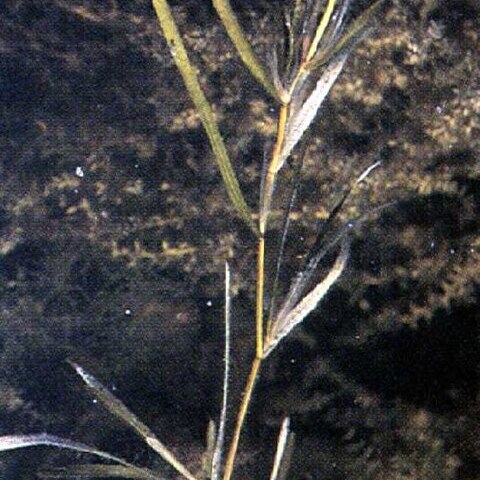Rhizomes absent. Cauline stems conspicuously flattened ("wing-flattened"), without spots, 60--120 cm; glands absent or rarely present, when present, gold, 0.3 mm diam. Turions common, terminal or lateral, 4--7.5 ´ 2--4.5 cm, firm; leaves ± 2-ranked; outer leaves 3--4 per side, base not corrugate, apex acute; inner leaves undifferentiated. Leaves submersed, ± spirally arranged, sessile, rigid; stipules persistent, conspicuous, convolute, free from blade, white, not ligulate, 1.5--3.5 cm, fibrous, shredding at tip, apex obtuse to acuminate; blade light green, linear, not arcuate, 10--20 cm ´ 2--5 mm, base rounded, without basal lobes, not clasping, margins entire, not crispate, apex not hoodlike, blunt, acuminate, or bristle-tipped, lacunae absent; veins 15--35. Inflorescences unbranched, emersed; peduncles not dimorphic, terminal, erect to ascending, occasionally recurved, cylindric, 2--5 cm; spikes not dimorphic, cylindric, 15--30 mm. Fruits light green to olive-green, quadrate-oblong or nearly orbicular, turgid, sessile, with abaxially keeled, not laterally keeled, 4--5 ´ 3--3.5 mm, keel winglike; beak erect, 0.6--1 mm; sides without basal tubercles; embryo with 1 full spiral. 2n = 52.
More
Stems elongate, freely branched, strongly compressed, 1–3 mm wide, mostly without nodal glands; rhizome scarcely developed; lvs all submersed, linear, 1–2 dm × 2–5 mm, acute or cuspidate, scarcely narrowed at base, with 1–3 main veins and numerous (to 35) very fine ones; stipular sheaths axillary, free, rather firm, 1–2 cm, obtuse to acuminate; winter-buds commonly produced, 4–7.5 cm, their lvs not strongly differentiated; peduncles stout, 2–5 cm, often curved; spike cylindric, 1.5–2.5 cm, with 7–11 whorls of fls; achenes broadly elliptic-ovoid, 4–4.5 mm, with a sharp but narrow, slightly dentate dorsal keel; 2n=52. Ponds and slow streams; Que. and N.B. to B.C., s. to Va., Ind., Io., and Calif. (P. compressus and P. zosterifolius, misapplied) A putative hybrid with no. 9 [Potamogeton strictifolius A. Benn] is P. ×haynesii Hellq. (P. longiligulatus, misapplied)

